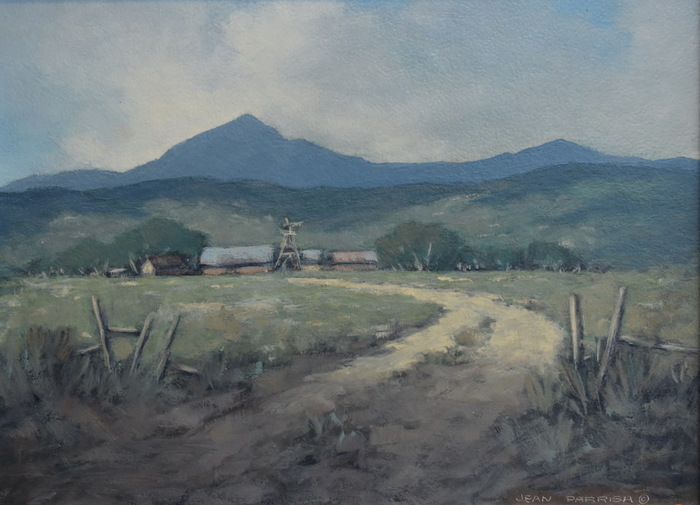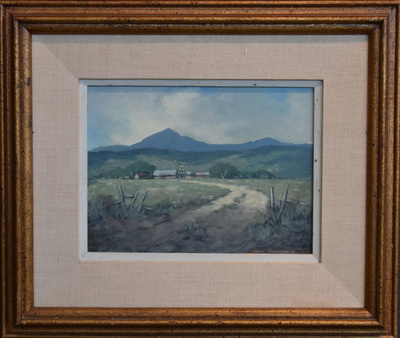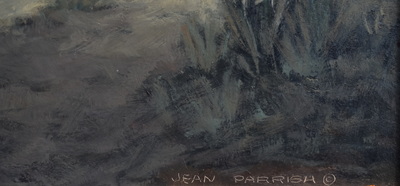Jean Parrish "The Ranch"
-
- Jean Parrish
- (1911 - 2004)
- New Mexico Artist
- Image Size: 9 x 12
- Frame Size: 17 x 20
- Medium: Oil
- "The Ranch"
- Contact for Price & Info
- View All By This Artist
-
Biography
Jean Parrish (1911 - 2004)
Jean Parrish, a Southwest landscape painter, was born June 26, 1911 at
her parents home at the Oaks in Plainfield, New Hampshire. She is
the only one of the children of illustrator Maxfield Parrish and his
wife Lydia Austin Parrish to become an artist.
In 1922, at the age of eleven, she posed for Maxfield Parrish's famous illustration, Daybreak, in which she is the vertical figure bending over the reclining figure. A photograph dated 1922, titled Jean Parrish Posing for Daybreak
is in the Special Collections of Dartmouth College Library, Hanover,
New Hampshire. She also posed for her father as the model
for Mary, Mary Quite Contrary and for Jack and the Beanstalk. According to Alma Gilbert in her book Maxfield Parrish, "The last painting with a human figure that Parrish did was for the famous Collier's cover, Jack Frost (1936), suggested by his daughter, Jean." (19)
Her schooling began in New York City with kindergarten and first grade
school. This was followed by being taught at home by outside
tutors when her mother returned to their home at The Oaks in
Plainfield, New Hampshire. At age fourteen, she enrolled at Ethel
Walker's School for Girls at Simsbury, Connecticut, and in 1929,
she entered Smith College in Northampton,
Massachusetts. She was there for a year and a half but soon
lost interest and chose not to stay and returned home. From 1931
to 1937 Jean played, dated, drank and loafed under the disapproving
eyes of her parents.
In 1937, she spent time in Haiti, teaching the children of a Haitian
plantation owner, and then married Augustus Seymour, a Harvard
Law School graduate whom she had met at Smith College. The couple
moved from New England to Albuquerque, New Mexico that year, and set up
Jean's studio facing the western slopes of the Sandia
Mountains. She worked and lived in Albuquerque excepting
for a period during World War II when the couple lived in Virginia to
accommodate his military service and later for the years 1960 to 1962,
when she moved to Cornish to care for her ailing father.
Because of her background, she had a long-time interest in art but was
not inspired to paint until she saw the mountain landscape of New
Mexico. When she was in Virginia, she painted southwest scenes
she recalled from memory, and then devoted much of her energy to
painting her surroundings when she and her husband returned to New
Mexico in 1946. Of her work she said: "When I paint I try
to mirror the way light sculptures the earth, the way shadows fall."
(Samuels 360)
In 1949, she and Seymour divorced, and her painting activities,
including exhibiting her work, became a central part of her
existence. She battled and conquered her alcoholism, and
was quoted about this in an article written for American Artist Magazine
by Mary Carroll Nelson titled "Jean Parrish: A Yankee in New
Mexico". She had a one-person exhibition at the Museum of New
Mexico in Santa Fe, and in 1955, she received "her first important
recognition when Tijeras Canyon earned her the grand prize in objective
art and a purchase prize at the New Mexico State Fair." (Kovinick
243) Other exhibition venues were the Ogunquit Art Center Show in
Maine; Artists of America Invitational in Denver; and American Artists
in St. Louis.
In the late 1950s, she went through a period of bad health, but in the
1960s, recovering her energy, she had the most productive time of her
painting career. Through most of her life, Maxfield Parrish
remained Jean's staunchest and most loyal supporter encouraging her and
helping her financially to achieve her goals. Their weekly
correspondence and his monthly checks allowed Jean to branch out and
achieve her goals. Despite all her disclaimers to the contrary,
his technique and usage of Dynamic Symmetry influenced his daughter
greatly. She loved building and built and designed her
studio with her own hands and little other help, also emulating the
parent that had built his own home and studio in New Hampshire.
Her mediums were oil and casein, and her western landscape subjects included mountain villages such as Truchas Revisited, skyscapes and the Navajo Indian reservations in Arizona such as Canyon de Chelly and Land of the Navajos. She also painted in California, Sacramento Mountains, and in Mexico where she depicted market scenes.
Jean Parrish's work is now included in the permanent collections of
several Southwest Art museums including the Museum of New Mexico in
Santa Fe. There is a street in Albuquerque named after her.
Jean Parrish Seymour almost lived as long as her father, Maxfield
Parrish. She passed away at the age of 94 in November, 2004.
Sources:
Phil Kovinick and Marian Yoshiki Kovinick, An Encyclopedia of Women Artists of the American West, p. 243.
Alma Gilbert, Director of the Cornish Colony Museum, Windsor, Vermont,
information sent to AskART on 2/2006 and edited this biography.
Her cited book is Maxfield Parrish, The Masterworks
Information submitted by Larry W. Greenly of Albuquerque, New Mexico, including the references: The Illustrated Encyclopedia of Artists of the American West by Peggy and Harold Samuels.


